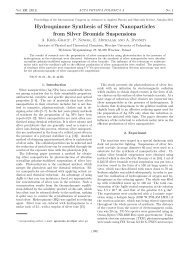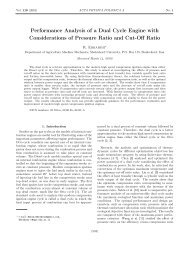Ultra Fine-Grained Metals Prepared by Severe Plastic Deformation ...
Ultra Fine-Grained Metals Prepared by Severe Plastic Deformation ...
Ultra Fine-Grained Metals Prepared by Severe Plastic Deformation ...
You also want an ePaper? Increase the reach of your titles
YUMPU automatically turns print PDFs into web optimized ePapers that Google loves.
746 J. Číˇzek et al.<br />
1. Introduction<br />
Over the past several decades it has become known that the refinement of<br />
grain size of the traditional polycrystalline metals below one micrometer can lead<br />
to a significant improvement of their mechanical, electrical, thermal, and other<br />
properties. This is why ultra fine-grained (UFG) metals, which are characterised<br />
with a mean grain size of several hundreds of nanometers, are nowadays attracting<br />
much attention of materials researchers as promising materials for various<br />
industrial applications. Among the methods of production of the UFG metals,<br />
those based on severe plastic deformation (SPD) are of a great importance, see<br />
Refs. [1, 2] for a review. Macroscopic amounts of UFG materials with no porosity<br />
can be obtained <strong>by</strong> means of SPD. The following important elements of the<br />
SPD-created UFG structures can be outlined:<br />
(i) Grains of the size of several hundreds of nanometers, which becomes comparable<br />
to typical diffusion lengths of free positrons in metals (≈ 100 nm).<br />
(ii) Grain boundaries (GB) whose integrated volume constitutes, contrary to the<br />
ordinary polycrystalline metals, a significant fraction of the total volume of<br />
the material.<br />
(iii) Defects introduced <strong>by</strong> SPD (dislocations, vacancies and vacancy clusters,<br />
GBs).<br />
The two techniques utilising SPD have recently been introduced to produce<br />
UFG structures in a wide class of metallic systems [2]:<br />
(a) The high-pressure torsion (HPT) is a technique capable to provide disk-<br />
-shaped specimens of the diameter of ≈ 10 mm and thickness of 0.2÷0.5 mm.<br />
The HPT-made specimens exhibit rather small grain size of ≈ 100 nm, homogeneous<br />
UFG structure, and a weak texture only.<br />
(b) The equal channel angular pressing (ECAP) can produce more massive specimens,<br />
however, the mean grain size usually appears to be larger compared<br />
to HPT.<br />
SPD process results in a highly non-equilibrium structure. It seems obvious<br />
that defects play a key role in formation of the UFG structure and lie beneath<br />
the extraordinary properties of these materials. Detailed defect investigations<br />
become thus highly desirable from the point of understanding the formation and<br />
thermal stability of the UFG structures. Positron annihilation spectroscopy (PAS)<br />
is a powerful non-destructive technique of microstructural studies of a variety<br />
materials [3]. It appears to be extremely sensitive to the small-sized open-volume<br />
defects. PAS thus seems to be an ideal tool for the investigation of the above listed<br />
UFG structure elements.<br />
In the present lecture, recent investigations of the HPT-prepared UFG metals,<br />
performed within a Prague–Rossendorf–Ufa collaboration, will be reviewed.<br />
PAS was utilised as the principal experimental technique including:





